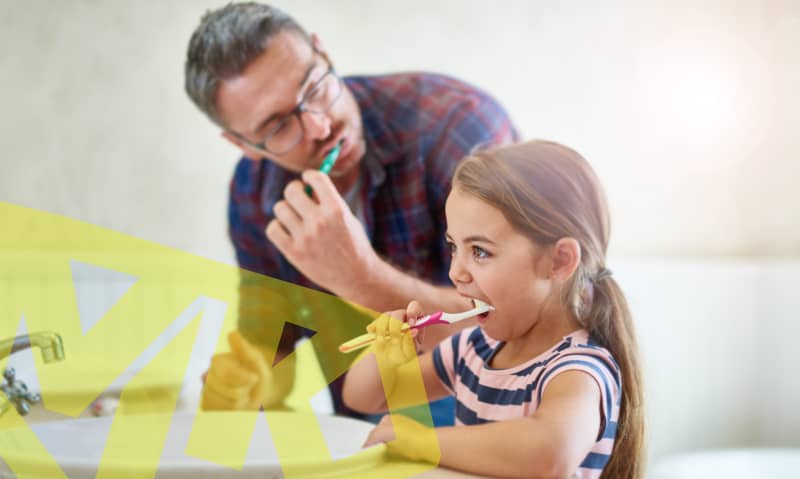How to Instill Tooth-Brushing and Flossing Habits

Help Your Children Build Habits for the Best Oral Health
Maintaining good oral health is a commitment that lasts a lifetime, so starting your children out with the right foundation is vital. There are some simple tips you can follow to make tooth-brushing and flossing come as naturally as possible to your kids:
Teach Your Children Oral Hygiene While They’re Young.
Teaching proper oral hygiene techniques to your child is a process that you should start as early as possible. Following recommendations for infant oral hygiene and walking through those steps with your child provides a strong foundation for them when it’s time to handle it on their own.
It’s important to wash your baby’s gums even before teeth emerge, and you can find special washcloths or brushes designed for this specific purpose. As the teeth do come in, you can start using a soft-bristled toddler toothbrush and a very small dab of toothpaste.
Around the age of three, it’s safe to transition to using a pea-sized dab of toothpaste. Your child will still need help brushing teeth, but they’ll likely start to show an interest in doing it themselves. While you’ll likely need to brush their teeth to ensure it’s done correctly, you can let them finish up by themselves to start familiarizing themselves with brushing on their own.
At about age five or six, kids should be brushing their teeth on their own. Of course, you’ll still need to supervise to ensure they’re maintaining proper brushing techniques, but defining brushing as their own responsibility at this point sets them up for a lifetime of proper oral hygiene.
Model Proper Oral Hygiene Behavior.
Children model their behavior from the people around them. As a parent, much of that falls on you. If you want your children to adopt proper oral hygiene habits, one of the best ways to do so is to make sure you’re keeping up with them yourself.
Ensure that you’re consistently brushing your teeth twice each day, even if you think your children aren’t taking notice. They likely are and won’t be happy about having to stick to a routine that you aren’t willing to follow. Brushing for the recommended two minutes during each brushing is also an important habit to model.
Don’t forget to floss at least once each day as well and make sure you’re doing so thoroughly. Even if your child might still need help with this, they’ll be more likely to adopt the habit themselves if they see that you’re doing it.
Develop Consistent Routines for Your Children.
Routines are incredibly important to children. They rely on a steady routine to remain confident in their daily lives, and oral hygiene needs to be a part of that routine. Try to make brushing and flossing take place at the same time each day to ensure a very well-grounded routine.
In most cases, brushing in the morning and at night is the easiest way to nail down a solid routine. You can incorporate flossing teeth at one of those times. It doesn’t really matter which. Nighttime is often the preferred choice as school age approaches due to time constraints in the morning.
These routines should be maintained consistently. Simply dropping in from time to time with intermittent reminders isn’t enough to build a strong routine. When starting out, the best way to make sure that the routine sticks is to enforce it very strictly, making sure that your child doesn’t miss any brushing times at all.
Focus on the Positives of Tooth-Brushing and flossing.
It’s easy to default to horror stories about tooth extractions and root canals to frighten children into brushing. However, this may not be the best approach. Instead, education about brushing can focus on the positives instead.
While discussing the potential consequences of not brushing is important, parents should emphasize the protection and health benefits of tooth-brushing and flossing. Excessive negative imagery can frighten children about oral health in general. Explain that brushing keeps teeth healthy and strong, rather than focusing on how not brushing leads to issues.
Using positive language can help. Reinforce brushing habits after your child has brushed by noting how clean and shiny their teeth look. Tell them they did a great job and that sticking with their routine will help them stay healthy and happy.
Keep Up with All Areas of Oral Hygiene.
A proper brushing technique is an important part of maintaining your child’s oral health, but so is ensuring they get the preventative dentistry treatments they need. Must Love Kids Pediatric Dentistry can provide for all of your child’s routine exam and teeth cleaning needs. Contact us today to schedule an appointment.